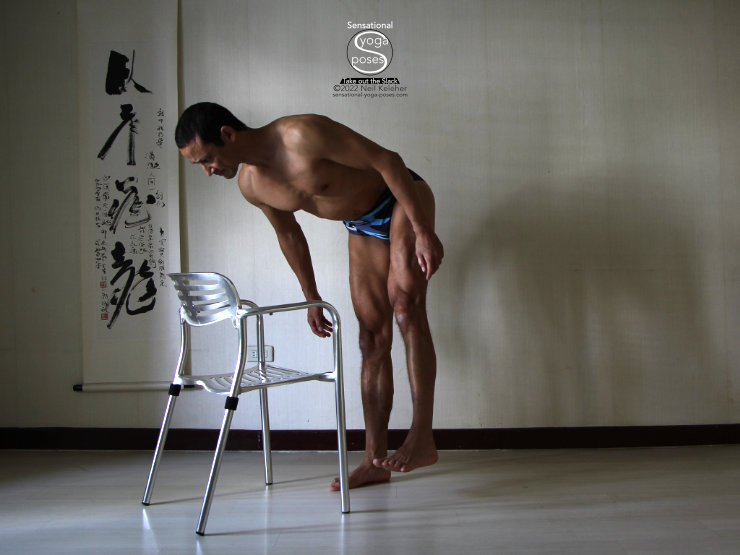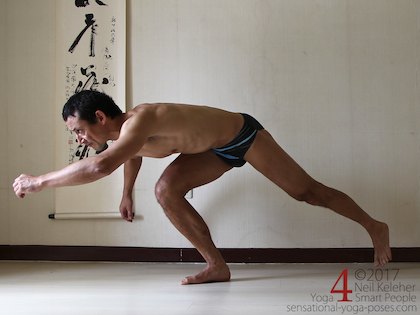Tips for Fixing Hip Pain In Standing Forward Bends
Taking a step back to figure out how to fix a gimpy hip
One of my favorite exercises is the one legged standing forward bend. This isn't the same as warrior 3 where the leg is back. Instead the lifted leg is pulled forwards and the hands can be on the floor, which is easier, or lifted, which is harder.
A variation is to stand up from this position.
I actually use this as a test of hip function.
My Gimpy Left Hip, It Hurts in Standing Forward Bends and Squats
I've had a gimpy left hip for awhile. It hurts in standing forward bends and even in squats.
The pain seems to be right between the pubic bone and the thigh, but perhaps a little back from the pubic bone (along the ischiopuboramus, the pair of which form the rockers (like on a rocking chair) of the pelvis.
The reason for using the one legged standing forward bend as a test is if I can do that (and stand up from it) without pain in the hip then I've successfully treated the problem.
Another test is from a lunge, lifting the back leg and stepping it forwards without hip pain. In this case, the forward leg is the leg being tested.
Failure and What to Do About It
I remember in math class, if you failed a test, if you got a question wrong, then you practiced the question that you had a problem with. And the same can be true here, sort of. In school the advantage was that generally you learned the things necessary to do what you are doing now.
With the body sometimes you have to take a step back to figure out the actions necessary to say, fixing a gimpy hip.
Playing with Various Hip Muscle Activations that Didn't Work
For me this meant learning and playing with various muscle actions for the hips. What I found was that none of my hip fixes worked until I learned to activate the calf and the back of the knee while also grounding the heel and outer edge of the foot.
That was the first instance where I was able to do the one legged standing forward bend without a problem.
But then the pain came back. And that's another thing with learning the body, sometimes you fix one problem, but another problem is thus revealed. So you keep at it.
Fixing the Lower Leg and Knee and then Fixing the Hip
After fixing the calf activation problem the next port of call was back to the hips.
Noticing and Adjusting Pelvic Positioning and Muscle Tension
What I've found is that when doing exercises like the one legged standing forward bend and the lunging leg lift, I've had to closely monitor the position and orientation of my pelvis relative to the standing leg. In addition I've had to monitor tension.
The Biceps Femoris and Ilitiobial Band
What I'm currently finding is that I need tension along the outside of the thigh to both the fibula and the tibia. This tension is created by, in the former case, the biceps femoris and in the latter by the tensor fascae latae and possibly fibers of the gluteus maximus via it the iliotibial tract.
The key to creating this tension is of course activating those muscles but the key to activating those muscles is positioning the pelvis in away that coerces them (or allows them or induces them) to activate.
So in a One legged standing forward bend on the left leg I find it helps to turn the pelvis to the right (away from the standing leg) but also to lift the right side of the pelvis. The feeling is that this position allows my glute maximus to create a downward pull on the psis (the rear point of the iliac crest) and that the psis is just to the outside of the sitting bone (to which the hamstrings attach) when viewed from the back.
Earlier on I also had a realization that perhaps the long head of the adductor magnus was also significant in this action. This muscle attaches to the inside of the thigh just above the knee joint and you could imagine a sort of overlapping action in the muscles needed to stabilize the hip and knee, sort of like the wire spokes of a bicycle wheel.
Note that previous explorations of the hip joint may have helped in all of this.
What I'm hoping is that after some practice I should be able to stand up from either the one legged standing forward bend or the lunge without having to focus on feeling my hip and/or leg. It will have become a subconscous movement pattern, a habit. And from there I'll be able to play with non-perfectly aligned variations.
Published: 2017 04 26
Updated: 2021 01 29




